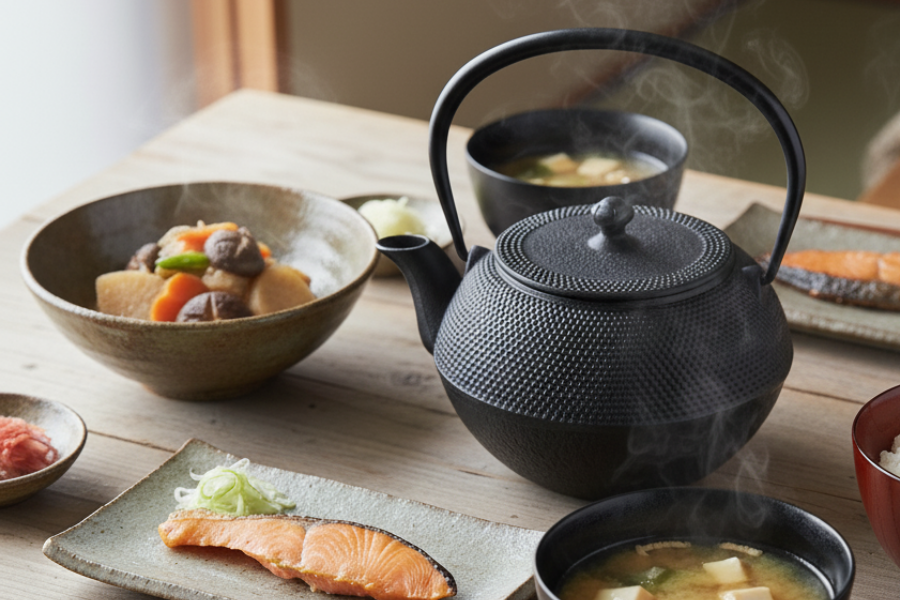Experience the comforting elegance of Japanese tableware this winter. From magewappa bento boxes and lacquered bowls to Shigaraki pottery and Nambu ironware teapots, find warmth for your table and gifts for loved ones.

As the lingering colors of autumn fade across Kyoto, people quietly begin preparing for the arrival of winter. The trees turn brilliant shades, leaves drift in the wind, and even the dining table subtly reflects the changing season. Winter invites us to slow down and enjoy moments of warmth and connection. On a Japanese winter table, handcrafted tableware brings a gentle warmth that complements the season’s quiet beauty.
1. Wooden Warmth for the Table: Magewappa and Lacquered Wooden Bowls
One of the most fitting materials for a winter table is wood. Wooden tableware carries the natural softness of trees, bringing warmth and comfort to cold days. Among these, magewappa bento boxes and lacquered wooden bowls represent centuries of Japanese craftsmanship.


Lacquered wooden bowls, coated with multiple layers of natural lacquer, are indispensable for winter soups and simmered dishes. The combination of warm wood and the deep sheen of lacquer makes them comforting to hold, while the smooth rim enhances the eating experience. Lacquer provides waterproofing and antibacterial properties, and over time, the bowls gain a rich patina that deepens with daily use. A winter table adorned with red and black lacquered bowls radiates subtle elegance and calm.
2. The Quiet Strength of Clay: Kiyomizu, Shigaraki, and Arita Ware

Japanese ceramics reflect the character of the land from which they come. For winter dining, Kiyomizu, Shigaraki, and Arita ware offer a serene and comforting presence.
Kiyomizu ware tea cups capture the city’s refined aesthetic. Lightweight and delicate, with subtle glazes that evoke winter mist, they bring a gentle calm to your tea moments.
Shigaraki ware plates and sake sets convey the raw power of the clay. The textured surfaces, natural ash glazes, and patterns formed by flames are simple yet deeply evocative. Pouring sake into a Shigaraki tokkuri, you experience the comforting warmth of the earth itself.
Arita ware small bowls and soy sauce dishes, with their refined white porcelain and indigo designs, add elegance to the table. Light and stackable, they easily complement modern lifestyles while enhancing seasonal dishes.
Shop Shigaraki ware collection
3. The Quiet Power of Iron: Nambu Ironware Teapots and Kettles

Another essential presence on a winter table is Nambu ironware, crafted in Iwate for centuries and still made by skilled artisans today.

Nambu Ironware Kettle "Maromi Arare 1.0L"

Iron teapots and kettles offer both striking beauty and practical warmth. Water boiled in an iron kettle has a naturally soft taste and retains heat for longer, making tea moments richer and more satisfying. The textured patterns on these vessels gain a deeper luster over time, connecting the user to the rhythm of daily life. Though made of metal, the weight and warmth of Nambu ironware convey a sense of grounding and serenity—truly a “warmth of iron” for the season.
Shop Nambu Ironware Teapots & Kettles collection
4. Winter Gifts: Sharing Warmth Through Tableware

Winter is a season when people naturally wish to share warmth with others, and Japanese tableware is a beautiful way to express that feeling.
Each gift has a story: Kiyomizu tea cups convey a wish for calm, reflective moments; Shigaraki sake sets encourage enjoying the year’s end with a sense of ritual; magewappa and lacquered bowls express hopes for health and cozy daily meals. Increasingly, Nambu ironware teapots and kettles are chosen as gifts. Their presence enhances everyday life, lasting for decades, and embodies the essence of Japanese craftsmanship. For international friends, they serve as a symbol of Japan’s tea culture and artisanal traditions. The deep, dark tones of ironware quietly shimmer in winter light, carrying the giver’s warmth with every use.
Gifting tableware is more than presenting something beautiful—it is a way to share your thoughtfulness. Every time the recipient uses it, the memory and care of the giver quietly return to them.
Gift collection 2025
5. Beauty in Stillness: What the Japanese Table Teaches Us

A Japanese winter table values quietness and harmony over ostentation. Here, one can feel the essence of wabi-sabi, a core principle of Japanese aesthetics: wabi reflects finding richness in simplicity and imperfection, while sabi honors the beauty that comes with age and time.
The uneven glaze of a ceramic plate, the gentle patina of a lacquer bowl, the textured depth of an iron kettle—all reveal beauty through use and time. These vessels are not merely objects; they invite a quiet dialogue between the user and the world, cultivating mindfulness and appreciation. On a winter table, each piece of tableware acts as a companion to the season, shaping meals into thoughtful, meditative moments.
Conclusion: A Table of Warmth and Connection
Japanese tableware transforms winter meals into moments of connection and comfort. Steaming pots at the family table, bowls of miso soup, and fragrant rice are all enhanced by the work of artisans and the natural materials from which they are made. This winter, welcome such warmth-infused tableware into your home, and consider sharing its comfort as a thoughtful gift for someone special.




